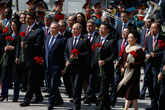Asia’s quest for a rules-based world order

Admiral Sun Jianguo (R), vice chief of staff of China's People's Liberation Army (PLA), meets with Russian Deputy Defense Minister Anatoly Antonov on the sidelines of the 14th Shangri-La Dialogue in Singapore, on May 30, 2015. Source: Photoshot/Vostock Photo
Held annually by the International Institute for Strategic Studies (IISS), the Shangri-La Dialogue (SLD) has established itself as the main forum for discussing security issues in the Asia-Pacific. It has become similar to the Munich Security Conference in Europe in the sense that observers always pay much attention to who says what, using the gathering as a barometer for regional trends and developments.
While last year the event of the season precluding the SLD was the China-Vietnam oil rig crisis, this time the context is somewhat different in form, but much the same in essence. The first months of 2015 brought almost weekly updates on new land reclamation activities on the reefs, shoals and islands of the South China Sea. Unlike last year’s explosive crisis, the construction works are more of a scaring tactic. This doesn’t make them legal, but it gives China (and other builder states) a moral argument of being a victim of provocation, should any of the other claimants or any outside power (namely the U.S.) try to demonstrate its denial of the right to build.
Ironically, Beijing’s shift to a more subtle strategy did not make the SLD an easier venue for the Chinese delegation to attend. U.S. Secretary of Defense Ashton Carter in his address was highly critical of China’s reclamation activities and attending experts witness that the country’s representatives got a lot of tough questions over the three days of the conference. It once again seemed like China was a besieged fortress, feared and bashed by neighboring countries small and large.
Though many are worried by China’s alleged expansion, the Asia- Pacific has actually been performing rather well in keeping its own stability. Still, the question of whether China can rise peacefully remains. It seems that the gap between China and U.S. on one hand and the rest of the resident powers on the other is so big that any kind of regional order will clearly be based on the balance of influence between the two. But as the keynote speaker of this year’s SLD Singaporean Prime Minister Lee Hsien Loong noted, it may be a system “where major powers strengthen their influence within a set of international rules and norms” and it may be one without such rules.
In this sense Asia is very similar to the rest of the world. The fight is not about who gets what, but rather about what are states allowed to do to get what they want. We have to acknowledge that wanting something, having interests is normal for a state. And it is as normal for other states to want something completely different. Competition and divergence will be happening time and time again, but there must be rules for managing these differences. The key here is to make sure that using force to safeguard a certain interest is more costly than engaging in meaningful negotiations.
The article is abridged. Read the full version at Asia.RBTH.com.
All rights reserved by Rossiyskaya Gazeta.
Subscribe
to our newsletter!
Get the week's best stories straight to your inbox
